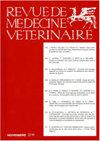Q2 Veterinary
引用次数: 11
摘要
牛寄生虫在哥伦比亚造成重大损失,它与蜱虫的存在有关。它是由微小的球内嗜血寄生虫如无形体和巴贝斯虫引起的。本研究对来自哥伦比亚科尔多瓦四个养牛场的131头纯Gyr奶牛进行了研究。从尾骨静脉采集5ml血样用于血细胞比容测定和血液涂片染色,以评估细胞内寄生形式与无形体和巴贝虫在形态上的相容性。采用卡方检验来确定身体状况、粘液颜色、性别和生产系统(放牧、半封闭和封闭)的变量是否独立于球内嗜血性寄生虫的频率。研究发现,24.43%的动物检出球内嗜血性寄生虫阳性;20.61%(27/131)无原体阳性;巴贝虫为3.05%(4/131),无形体虫和巴贝虫均为0.76%(1/131),粘液颜色、性别和生产方式(放牧、半坐月子和坐月子)的差异均无统计学意义(p > 0.05)。这使得首次记录了印度牛(特别是Gyr品种)中球内嗜血性寄生虫感染的流行情况。本文章由计算机程序翻译,如有差异,请以英文原文为准。
Prevalencia de parásitos hematrópicos endoglobulares en bovinos gyr puros en Córdoba, Colombia
Bovine parasitic sadness produces significant losses in Colombia and it is associated with the presence of ticks. It is caused by microscopic endoglobular hemotropic parasites such as Anaplasma spp. and Babesia spp. In this study, 131 pure Gyr cows were studied from four cattle farms in Cordoba, Colombia. A blood sample of 5 ml was collected from the coccygeal vein for hematocrit determination and for blood smears stained with Wright’s stain, in order to assess intracellular parasitic forms morphologically compatible with Anaplasma spp. and Babesia spp. Chi-square test was used to determine whether the variables of body condition, mucous color, sex and production system (grazing, semi-confinement, and confinement) were independent from the frequency of endoglobular hemotropic parasites. The study found that 24.43% of the sampled animals were positive for endoglobular hemotropic parasites; 20.61% (27/131) of them were positive for Anaplasma spp.; 3.05% (4/131) for Babesia spp., and 0.76% (1/131) for both Anaplasma spp. and Babesia spp. No significant differences (p > 0.05) were found for variables of mucous color, sex and production system (grazing, semi-confinement, and confinement). This allowed to register for the first time the prevalence of infection by endoglobular hemotropic parasites in Bos indicus cattle, of the Gyr breed specifically.
求助全文
通过发布文献求助,成功后即可免费获取论文全文。
去求助
来源期刊

Revue De Medecine Veterinaire
农林科学-兽医学
CiteScore
1.30
自引率
0.00%
发文量
0
审稿时长
18-36 weeks
期刊介绍:
The Revue de Médecine Vétérinaire publishes four kinds of text:
1) Scientific reviews on subjects related to veterinary and comparative medicine. Suggested length: 10 to 30 typed pages.
2) Original reports on fundamental or applied research. Suggested length: 10 to 15 typed pages.
3) Continuous education articles, that should be easily understandable by non-specialists. Suggested length: 10 to 15 typed pages.
4) Clinical reports. Suggested length: 5 to 15 typed pages.
The publication can be done in French language or English language.
For an article written in English by not english native speakers authors, the manuscript must be subjected by attesting that it was read again by an anglophone scientist or a scientific translator.
The authors must certify that the manuscript was not published or subjected for publication to another review.
The manuscript must be accompanied by a sheet signed by all the joint authors indicating their agreement for the tender of the manuscript.
The publication is free but a financial participation could be required for the photographs color. An estimate will be sent to collect the agreement of the authors.
 求助内容:
求助内容: 应助结果提醒方式:
应助结果提醒方式:


